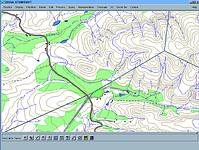CDSM migrates to PC-based system
April 2001
Recently, the Chief Directorate: Surveys and Mapping (CDSM) decided to migrate its 12 Laser-Scan LAMPS2 licences from Sun UNIX to Windows NT. It was planned that the LAMPS2 user workstations would move to Windows NT, but the LAMPS2 database would be kept on the UNIX server, due to its stability. In addition they also bought an extra three LAMPS2 licences. All 15 LAMPS2 workstations are to be used in their map production flow lines.

Picture generated on LAMPS2 system compliments of CDSM
As part of the migration, CDSM purchased 15 NT workstations. Each workstation has an Intel-based CPU (Pentium III 600) with 256MB onboard memory. They also have integrated 4MB video adapters piping to 21-inch monitors.
Cross-platform communication (between UNIX and Windows NT) created a huge speed problem. After installation, the CDSM 'IT' division duplicated the 'working' UNIX-based LAMPS2 database onto an NT server. It was decided by CDSM, after extensive testing by them, that a single platform (Windows NT) solution gave much better performance than the cross-platform installation (UNIX and Windows NT). An Oracle ODBC client was installed on each of the NT workstations, which allowed the NT LAMPS2 workstations to read/write into the Oracle database. The Laser-Scan Data Access Manager (DAM) was installed on one of the NT workstations, to manage all connections to the NT LAMPS2 database. Essentially, this meant that all the NT workstations were able to access both the NT LAMPS2 'object-oriented' database and the Oracle7 'relational' database.
A number of benefits have resulted from the migration to a fully Windows NT solution. Firstly, performance gains "not even dreamt about prior to the upgrade" were immediately observed. The use of NT workstations has meant a significant speed increase compared to the previous UNIX workstations. As a guideline, a performance increase of over 500% was noticed when performing a screen re-draw. (Editor's note: To put the speed increase into perspective, the original hardware configurations comprised a server running at 167 MHz with 64 MB RAM and workstations running at only 110 MHz with 128 MB RAM. It would have been interesting to see what performance increase would have occurred had the CDSM upgraded to the latest UNIX systems.)
This speed enhancement has added to CDSM's productivity and helped increase quality assurance in their flowline. These improvements contributed to the already increased monthly map output by CDSM. Secondly, ease of maintenance is also a benefit, since all the PCs can be maintained in-house. Thirdly, user operation and training of new operators on the Windows NT platform will be easier, since the user in most cases is already PC literate.
All fifteen LAMPS2 seats are now fully operational on an NT platform, and ongoing maintenance is being provided by Racal Aviation Systems to sustain the successful implementation of this solution.
GIS & IT Division
Racal Aviation Systems
(021) 936 8100
Others who read this also read these articles
An intelligent, integrated approach
MapIT has crafted a Licensed Partner programme based on the common requirement for highly accurate mapping data[ October 2004 ]
Picture it ...
MarketScope can calculate virtually any demographic scenario for your marketplace, taking into account a variety of factors, including your customer profiles, census information, competitor analysis data and any other set of business-related statistics you wish to evaluate, and visually display the results, arriving at an answer within 30 seconds[ August 2004 ]
Mondi develops advanced GIS business system
Mondi Forests has a truly integrated GIS business system that not only takes care of daily operational requirements, but also facilitates the use of GIS decision-making technology[ June 2003 ]
Implementation of a GIS system in local government
The most cost effective and user friendly way of implementing the MIS system and making it accessible to all authorised officials and Councillors throughout the Municipality was to build a Web application using Bentley Publisher[ April 2003 ]
GIS technology saluted for social and economic contributions
GIS is a powerful analytical tool that integrates spatial (or location) data with associated information, presenting the result in an easy-to-understand, map-based format[ February 2003 ]
ArcGIS Schematics launched
ArcGIS Schematics offers a high degree of flexibility and is not limited by the evolution of the data model and by changing database locations[ February 2003 ]
Building a locations-based service
Before we can start any project, we need to know and understand what the system is going to be used for[ August 2002 ]
Sustainable fisheries and marine conservation in Kenya
A Microsoft Access database is being developed to manage the data[ August 2002 ]
Others who read this also read these news items
Hikers, bikers and urban street pioneers
[ December 2005 ]
Image compression provides post-Katrina aerials within days
[ December 2005 ]
Navigation - the tip of the GIS iceberg
[ October 2005 ]
Fun and affordable in-car navigation
[ October 2005 ]
Cycling on the edge
[ October 2005 ]
Routing made easy
[ August 2005 ]
MapIT expands into West Africa
[ August 2005 ]
Incredible Connection powers navigation tools
[ August 2005 ]
Others who read this also read these regulars
ArcIMS 9.1 Route Server - routing and geocoding
[ October 2005 ]
Enterprise GIS with ArcGIS 9: a comprehensive GIS platform
[ October 2004 ]
GIS in Africa
[ August 2003 ]
Complete logistics and routing solution
[ August 2002 ]
ESRI offers highly integrated GIS solutions
[ April 2002 ]
GIS - the tool to help manage change in the 21st century
[ April/May 2000 ]
GIS software that sets a new standard
[ April/May 2000 ]
Search Site
Subscribe
Previous Issues
Other Technews Publications
Other Technews Buyers Guides
 |  | Copyright c1995-2009 Technews Publishing (Pty) Ltd.. All rights reserved. |